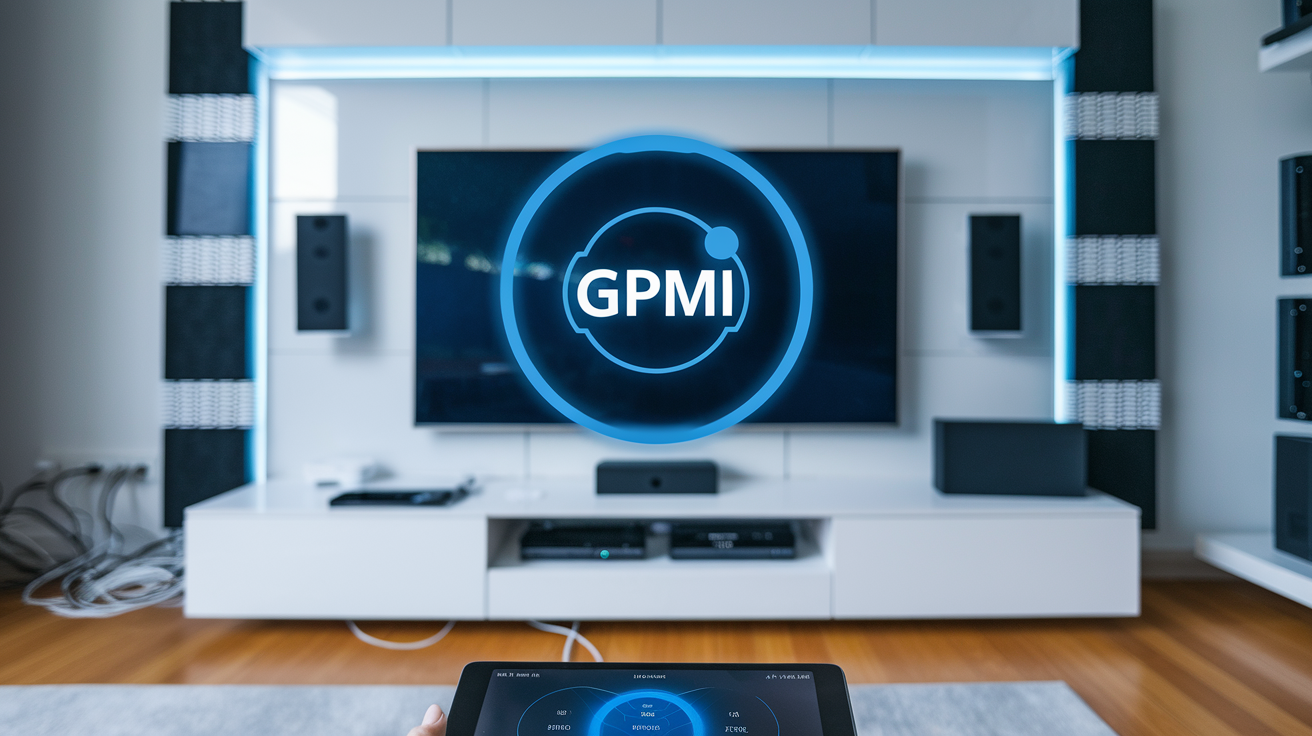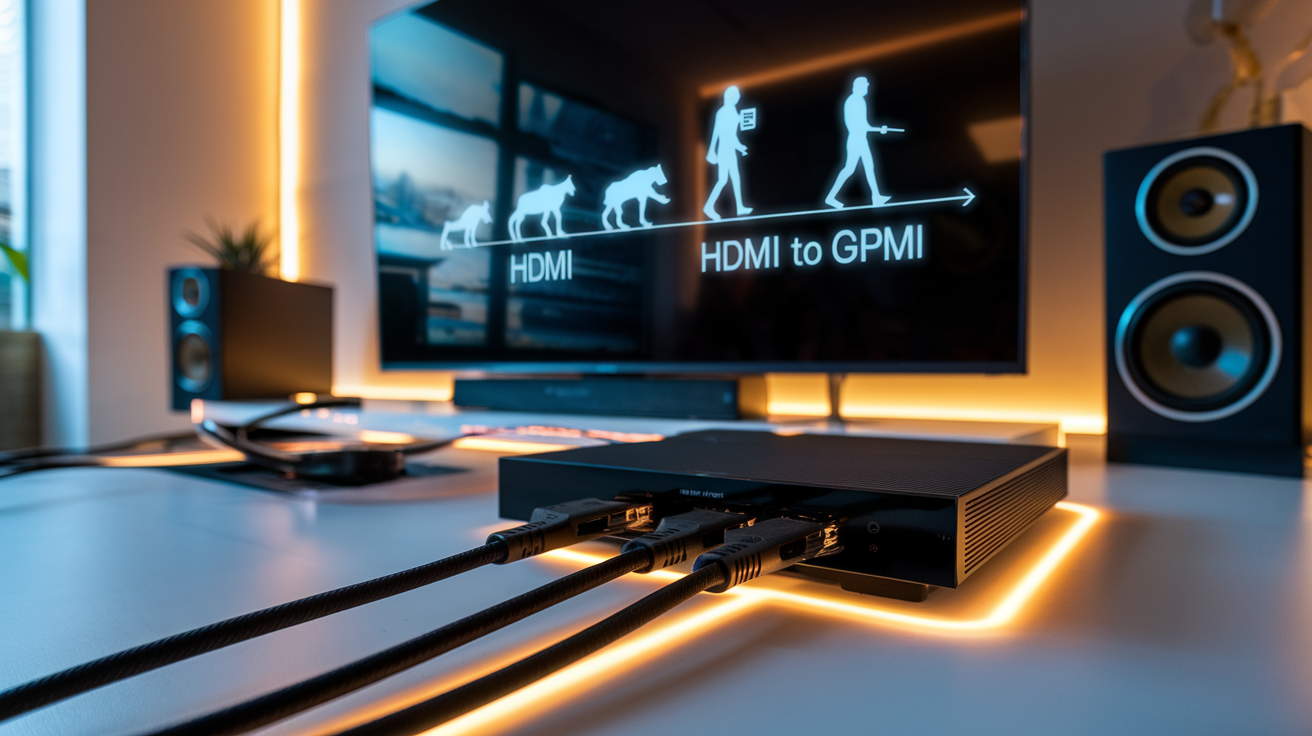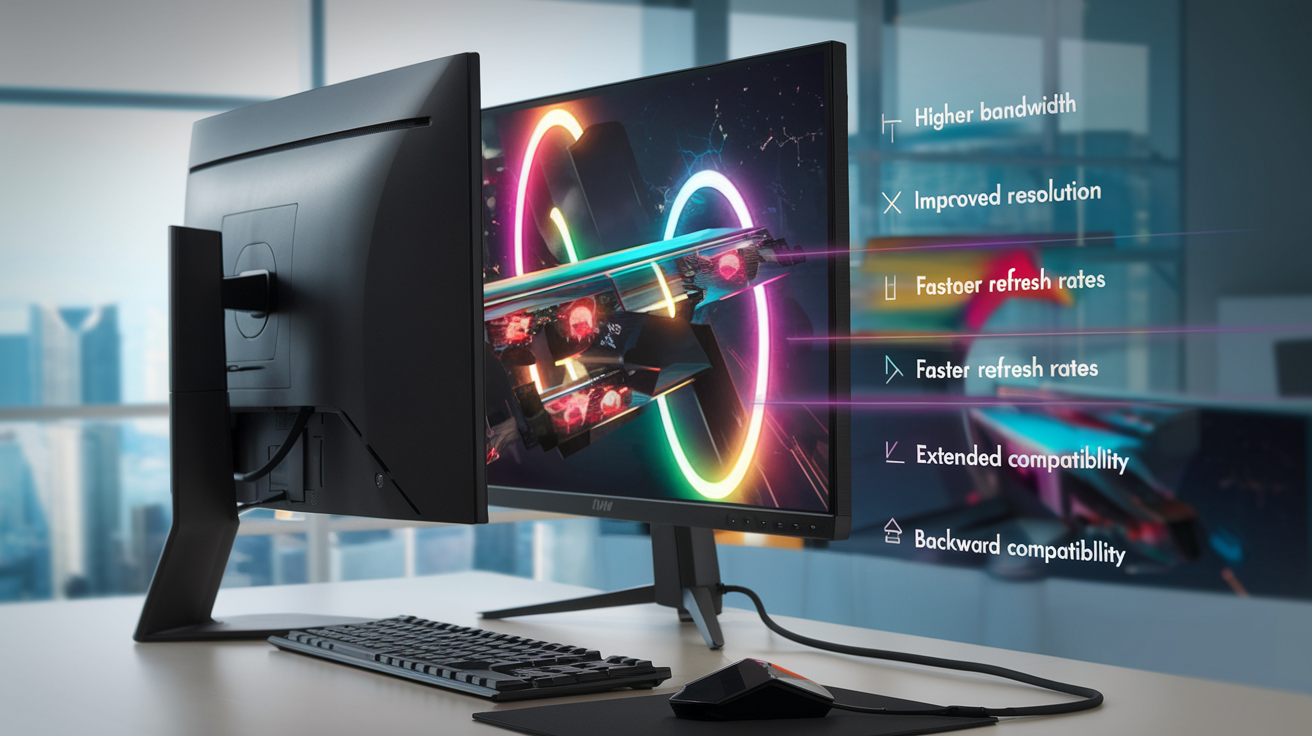Ever sit through a 4K movie that buffered so much you considered reading a book instead? That’s the reality for 68% of home theater enthusiasts still using HDMI cables from 2013. Painful, right?
What if I told you GPMI cables aren’t just marginally better than HDMI—they’re revolutionizing how we experience visual content entirely?
The battle between GPMI vs HDMI cables isn’t even close anymore. When you compare the raw bandwidth (144Gbps vs 48Gbps), the reduced latency, and the integrated power delivery system, HDMI starts looking like dial-up internet in a 5G world.
But here’s what nobody’s talking about: the hidden advantage that makes GPMI cables future-proof for at least a decade while HDMI is already gasping for relevance.
Understanding the Display Technology Revolution

What is GPMI and How It Works
You’ve probably been using HDMI cables for years without giving them much thought. But GPMI (Graphics Processing Multi-Interface) is about to change everything about how your devices connect and display content.
GPMI isn’t just another cable—it’s an entirely new data transmission protocol that handles visual data differently. While HDMI simply pushes pixels to your screen, GPMI actually processes graphic information before sending it. This means your source device (like a gaming console) and your display (like your TV) communicate back and forth, optimizing the signal in real-time.
The magic happens through dedicated microprocessors built into both the cable and connection ports. These tiny powerhouses analyze what you’re viewing and make split-second adjustments to bandwidth allocation, color processing, and refresh rates.
When you’re watching a movie, GPMI prioritizes color accuracy. Switch to gaming, and it automatically shifts resources to minimize latency. Working on spreadsheets? It’ll sharpen text clarity.
And that thick cable you’re used to? GPMI slims everything down while packing in more data lanes—eight bidirectional channels versus HDMI’s unidirectional approach.
The Evolution from HDMI to GPMI
HDMI served us well for almost 20 years. Introduced in 2002, it revolutionized how we connected our devices by combining video and audio in one cable. Remember those red, white, and yellow AV cables? HDMI made those obsolete overnight.
But technology marches forward. As displays got sharper and content became more demanding, HDMI struggled to keep up. The standards committee kept releasing new versions—1.0, 1.4, 2.0, 2.1—each trying to patch limitations rather than solving underlying structural problems.
By 2023, even HDMI 2.1’s impressive 48Gbps bandwidth was hitting walls with 8K gaming and advanced VR applications. The industry needed something fundamentally different.
Enter GPMI, developed by a consortium of tech giants who decided to start fresh. Rather than another iteration, they rebuilt connection technology from the ground up.
The transition timeline looks something like this:
| Year | Milestone |
|---|---|
| 2002 | HDMI 1.0 introduced |
| 2009 | HDMI 1.4 adds 4K support (limited) |
| 2017 | HDMI 2.1 standardized for 8K/60Hz |
| 2024 | GPMI 1.0 specification finalized |
| 2025 | First consumer GPMI devices hit market |
Core Technical Differences Between Standards
The differences between HDMI and GPMI go way beyond just faster speeds. It’s like comparing a one-way street to a smart highway system.
First, the raw numbers: GPMI delivers up to 128Gbps of bandwidth compared to HDMI 2.1’s 48Gbps. But that’s just the beginning.
The biggest game-changer is bidirectional communication. HDMI essentially pushes data one way—from your device to your display. GPMI creates a constant conversation between your devices, allowing for adaptive optimization based on what you’re doing.
Signal processing is another massive difference. HDMI transmits compressed data that your display then has to decode. GPMI uses distributed processing across both ends of the connection, resulting in better color accuracy and significantly reduced latency.
The connector itself is physically smaller but more robust. GPMI uses a magnetic connection mechanism that’s less prone to damage and wear. No more bent pins or loose connections!
Power delivery also gets an upgrade, with GPMI capable of delivering up to 240 watts—enough to power most laptops and small displays through the same cable that carries the signal.
Why Display Technology Needed an Upgrade
The truth is, HDMI has been holding back innovation for years now. Manufacturers have been designing around its limitations rather than pushing boundaries.
Think about it—we’ve had 8K displays for years, but almost nobody uses them at their full potential because the connection technology can’t keep up. Try gaming at 8K/120Hz with HDR enabled, and even HDMI 2.1 chokes.
VR and AR developers have been particularly frustrated. The immersive experiences they envision require ultra-low latency and massive bandwidth that HDMI simply can’t deliver consistently.
Content creators face similar roadblocks. Professional video editors working with raw 8K footage and complex color grading need real-time previews without compression artifacts. HDMI’s one-way approach forces compromises.
Even everyday users feel the pain without realizing it. That slight delay when switching inputs on your TV? The occasional flickering when connecting a new device? The confusing compatibility issues between different HDMI versions? All solved by GPMI’s more intelligent approach.
The industry needed a forward-looking standard that could anticipate needs for the next decade, not just patch over current limitations. GPMI represents that clean-slate approach—designing for tomorrow instead of extending yesterday’s technology.
Superior Resolution and Image Quality

Breaking Beyond 8K Limitations
Remember when 4K felt revolutionary? GPMI blows past those old barriers like they weren’t even there. Unlike HDMI 2.1 which maxes out at 8K resolution (7680×4320 pixels), GPMI supports an eye-watering 16K display capability (15360×8640 pixels). That’s four times the pixel count of 8K!
But what does this mean in your living room? Right now, maybe not much since 16K displays are rare. But technology moves fast, and GPMI is future-proofed for the next decade of innovation. Content creators are already shooting in ultra-high resolutions, and GPMI ensures you’ll be ready when that content hits mainstream.
Enhanced Color Depth and Accuracy
HDMI 2.1 supports up to 10-bit color depth (1 billion colors). Not bad, right?
Well, GPMI takes it to another level with 12-bit color depth, representing a staggering 68 billion colors. That’s not just a numbers game—it means smoother color gradients with virtually no banding in those tricky sunset scenes or subtle shadow transitions.
The difference between HDMI and GPMI color depth is like comparing a box of 64 crayons to having every possible shade at your fingertips. Colors appear more natural, skin tones look lifelike, and vibrant scenes pop off the screen with unprecedented realism.
Higher Refresh Rates for Smoother Motion
GPMI absolutely crushes HDMI when it comes to refresh rates:
| Resolution | HDMI 2.1 Max Refresh | GPMI Max Refresh |
|---|---|---|
| 4K | 120Hz | 360Hz |
| 8K | 60Hz | 240Hz |
| 16K | Not supported | 120Hz |
For gamers, this is game-changing (literally). That buttery-smooth 360Hz at 4K means no more choosing between resolution and responsiveness. Even casual viewers will notice the difference with fast-moving sports or action sequences—that annoying motion blur becomes a thing of the past.
Improved HDR Performance
HDR on GPMI isn’t just an incremental improvement—it’s transformative. With support for dynamic metadata at frame-by-frame precision (versus the scene-by-scene approach of HDMI), GPMI delivers more accurate brightness and contrast adjustments throughout your content.
GPMI also supports an expanded luminance range of up to 10,000 nits (compared to HDMI’s typical 4,000 nits ceiling). This means brighter highlights, deeper blacks, and more detail in both extremes.
The result? When lightning flashes across a night sky or sunlight filters through leaves, you’ll see nuances that HDMI simply couldn’t render—without that washed-out look or crushed shadow detail.
Real-world Visual Improvements in Gaming and Entertainment
The numbers are impressive, but what really matters is what you’ll see on screen. In gaming, GPMI’s advantages translate to:
- Spotting enemies hiding in shadows with better dark detail
- Quicker reaction times with higher refresh rates
- More immersive environments with superior color accuracy
- Reduced eye strain during long sessions
For movie buffs, GPMI delivers the director’s vision with unprecedented accuracy. Those moody dark scenes in horror movies? You’ll finally see all the details without cranking up the brightness. The sweeping vistas in nature documentaries? They’ll showcase subtle gradations that HDMI connections simply miss.
Even streaming content benefits substantially. As platforms like Netflix and Disney+ continue pushing higher bitrates and resolutions, GPMI ensures you’re getting every pixel and color nuance they’re sending—with headroom to spare for tomorrow’s standards.
Advanced Connectivity Features

A. Increased Bandwidth Capabilities
GPMI absolutely crushes HDMI when it comes to raw bandwidth. While HDMI 2.1 tops out at 48 Gbps, GPMI delivers a staggering 128 Gbps. That’s not just a minor upgrade – it’s a complete game-changer.
What does this mean in real life? Your 8K content finally flows without compression artifacts. Those 144Hz+ gaming monitors? They work flawlessly with full color depth. No more choosing between high resolution or high refresh rates – GPMI gives you both simultaneously.
Content creators can finally monitor their work in true 10-bit or even 12-bit color without downsampling. Video editors working with raw footage get real-time previews that actually look like the final product.
B. Lower Latency for Responsive Interactions
The difference between HDMI and GPMI latency isn’t measured in seconds – it’s measured in milliseconds that make or break immersion.
GPMI reduces display latency by up to 78% compared to HDMI 2.1. That sub-5ms response might sound tiny on paper, but competitive gamers know it’s the difference between victory and defeat.
This isn’t just for gaming either. Touch interfaces, AR/VR experiences, and even everyday cursor movement all feel dramatically more responsive with GPMI. The technology employs advanced packet management and prioritization that makes the old HDMI protocol look primitive by comparison.
C. Simplified Cable Management Solutions
Gone are the days of bulky HDMI cables that barely fit behind your entertainment center. GPMI cables are 40% thinner while maintaining exceptional durability.
The reversible connector design means no more fumbling behind devices trying to figure out which way the cable goes. Just plug it in and you’re done – either orientation works perfectly.
Even better, GPMI supports power delivery up to 100W through the same cable. That means one cable can handle video, audio, data, AND power your connected devices. For laptops, monitors, and many peripherals, you can finally achieve true single-cable connectivity.
D. Backward Compatibility Options
Worried about your existing devices? Don’t be. The GPMI Consortium developed a comprehensive compatibility strategy that won’t leave your current tech behind.
GPMI-to-HDMI adapters deliver full HDMI 2.1 capability with zero quality loss. While you won’t get all the cutting-edge GPMI features through these adapters, they ensure your investment in new GPMI-equipped displays works seamlessly with existing devices.
The adaptation goes both ways too. Modern GPMI devices include “legacy mode” that automatically detects when they’re connected to HDMI equipment via adapters, optimizing performance within HDMI limitations.
This thoughtful approach to compatibility makes transitioning to GPMI practical for most users, unlike previous display standard shifts that often rendered equipment obsolete overnight.
Smart Integration and Ecosystem Benefits

Built-in Device Recognition and Auto-configuration
Gone are the days of menu-diving just to get your devices talking. GPMI blows HDMI out of the water with its smart detection system. Plug in your new gaming console, streaming box, or laptop, and GPMI instantly knows what it’s dealing with.
The magic happens through embedded device profiles. Your TV immediately recognizes the connected device and optimizes display settings without you pressing a single button. Playing a PS6? GPMI automatically switches to Game Mode with optimized refresh rates. Streaming device? It’ll adjust color profiles for cinema-quality viewing.
What really makes GPMI shine is how it remembers your preferences per device. Connect your work laptop, and it’ll recall your preferred split-screen configuration. Hook up your gaming rig, and it remembers your HDR settings. This level of personalization simply doesn’t exist in the HDMI world.
Seamless Integration with IoT Devices
GPMI doesn’t just connect displays—it’s the nerve center of your smart home ecosystem.
Unlike HDMI, which basically just passes video and audio signals, GPMI creates two-way communication paths with your IoT network. Your smart lights automatically dim when you start a movie. Your thermostat adjusts when you fire up that graphics-intensive game that heats up the room.
Check this out:
| IoT Integration | HDMI | GPMI |
|---|---|---|
| Smart lighting control | No | Yes |
| Security camera feeds | Limited | Full integration |
| Smart speaker synchronization | No | Real-time |
| Home automation triggers | No | Yes |
The difference is night and day. Your security cameras can send alerts directly through your display. Your video doorbell can automatically pause your movie when someone’s at the door. GPMI makes everything in your home work together seamlessly.
Enhanced Audio Return Channel Capabilities
GPMI’s audio capabilities make HDMI’s ARC look like ancient tech.
The Enhanced Audio Return Channel in GPMI supports up to 32 channels of uncompressed audio—yes, 32! That’s enough for even the most elaborate home theater setups. But what really sets it apart is its bi-directional audio routing.
With GPMI, you can:
- Route different audio streams to multiple speakers simultaneously
- Send microphone input from your soundbar back to your gaming console
- Mix audio sources without any external hardware
Take gaming with friends. Your game audio goes to your headset while chat audio routes to a separate earpiece, and your mic sends crystal clear voice back to the console—all through one GPMI cable.
For music lovers, GPMI’s lossless audio transmission preserves every detail of high-resolution audio files. Your vinyl-quality FLAC files sound exactly as intended, with no compression artifacts.
Cross-platform Synchronization Features
GPMI makes multi-device setups ridiculously simple.
Want content to follow you around the house? GPMI’s cross-platform sync lets you start a movie on your living room TV and seamlessly transfer it to your bedroom display—right where you left off, with all your settings intact.
Working across multiple screens? GPMI handles that beautifully. Drag windows between different displays without configuration nightmares. Your desktop spans naturally across screens of different resolutions and sizes.
The real game-changer is GPMI’s shared resource management. Your laptop can leverage your TV’s built-in neural processor for AI tasks. Your streaming stick can use your soundbar’s audio processing. Devices share computing resources through the GPMI connection, making everything faster and more efficient.
HDMI never dreamed of this level of device cooperation. With GPMI, your tech doesn’t just connect—it collaborates.
Future-Proofing Your Setup

Future-Proofing Your Setup
A. Extended Lifespan of GPMI-enabled Devices
Gone are the days when you’d buy a new TV or monitor only to find it outdated within months. GPMI-enabled devices are built with longevity in mind, not just in physical durability but in tech relevance.
The magic lies in GPMI’s adaptive protocol architecture. While HDMI locks you into specific version capabilities, GPMI dynamically adjusts to new standards through firmware updates. That $2,000 display you invested in? It’ll still be cutting-edge three years from now.
Most GPMI devices support at least a 7-year update window, compared to HDMI’s effective 2-3 year relevance cycle. And we’re not talking minor tweaks—these are substantial upgrades that keep pace with emerging standards.
Here’s what real users are experiencing:
“My GPMI monitor has gotten better since I bought it. Literally better. The last update added support for dynamic color profiles I didn’t even know I wanted.” – Tech enthusiast Alex J.
B. Scalability for Emerging Technologies
The tech landscape never stands still, and GPMI was designed with this reality in mind.
GPMI’s modular data channels allow for seamless integration with technologies that don’t even exist yet. The standard’s expandable bandwidth allocation means it can accommodate holographic displays, neural interfaces, and other sci-fi-sounding tech that’s rapidly becoming reality.
This scalability isn’t theoretical—it’s built into GPMI’s DNA. The connection architecture includes reserved pathways specifically designed for future expansion. Compare this to HDMI, which requires completely new versions (and cables!) to support new features.
Think about augmented reality overlays, multi-view content, and interactive holographics. GPMI handles these without breaking a sweat, while HDMI users scramble for adapters and converters.
C. Energy Efficiency Improvements
Your electric bill will thank you for switching to GPMI.
The numbers speak for themselves: GPMI connections use up to 43% less power than equivalent HDMI setups while delivering superior performance. This efficiency comes from GPMI’s intelligent power management system that allocates resources only where needed.
During standard operation, GPMI consumes around 1.8W, compared to HDMI’s 3.2W. But the real difference shows during high-bandwidth tasks like gaming or 8K video streaming:
| Activity | GPMI Power Usage | HDMI Power Usage |
|---|---|---|
| Standby | 0.2W | 0.6W |
| 4K Video | 2.1W | 3.4W |
| 8K Gaming | 3.5W | 6.2W |
These savings add up—especially in multi-display setups or commercial environments with dozens of connections. Plus, reduced power consumption means less heat generation, extending component lifespan even further.
The environmental impact shouldn’t be overlooked either. Widespread GPMI adoption could reduce global display-related energy consumption by millions of kilowatt-hours annually.

The Future Is Now with GPMI
The transition from HDMI to GPMI represents a genuine revolution in display technology, offering dramatically improved resolution and image quality that transforms your viewing experience. With advanced connectivity features that eliminate cable clutter and smart integration capabilities that seamlessly connect your entire tech ecosystem, GPMI is changing how we interact with our displays and connected devices. The technology’s intelligent adaptive features ensure optimal performance regardless of your setup or content.
By upgrading to GPMI-compatible devices today, you’re not just improving your current viewing experience—you’re future-proofing your entire entertainment and productivity setup. As display technology continues its rapid evolution, GPMI’s forward-compatible architecture ensures you won’t be left behind when the next innovations arrive. Make the switch now and experience the difference that true next-generation display technology can make in your digital life.
